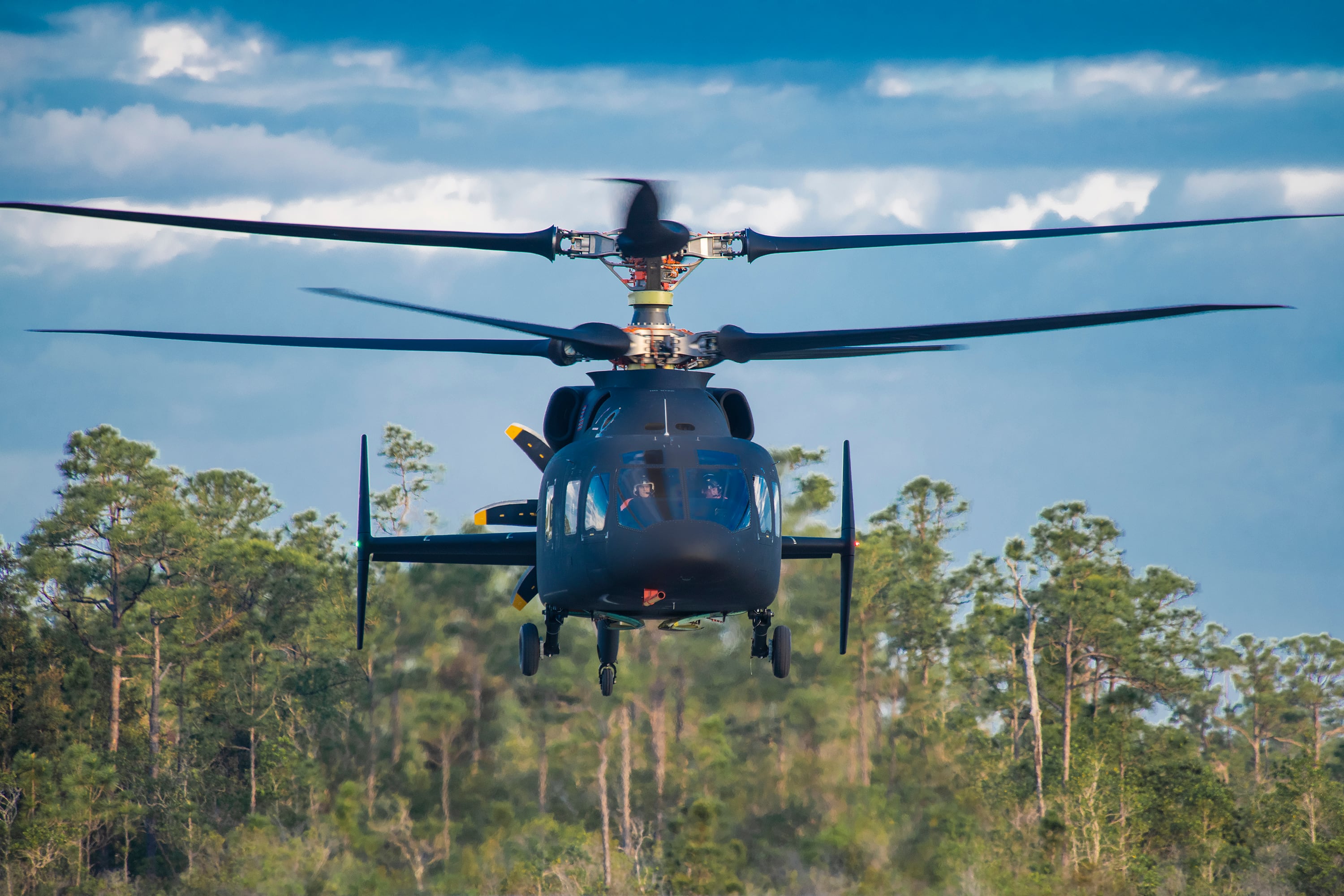WEST PALM BEACH, Fla. — Three of Lockheed Martin’s Sikorsky’s experimental helicopters flew together for the first time in a public demonstration Feb. 20 at the company’s flight test facility.
The Sikorsky-Boeing SB-1 Defiant coaxial demonstrator made its public flight debut reaching a cruise speed of 140 knots and demonstrating low-speed agility at lower acoustic levels compared to a conventional helicopter. The audience included Army Secretary Ryan McCarthy and Sen. Tammy Duckworth, D-Ill., a former U.S. Army UH-60 Black Hawk pilot whose aircraft was shot down in Iraq in 2004.
Sikorsky’s President Dan Schultz told the audience at the demonstration that Defiant’s flight is representative of almost $500 million of investment in over 12 years of development. Since it’s first flight in March 2019, Defiant has logged 24 hours of flight time over 13 flights. The aircraft has flown almost every week in 2020 so far as it continues to push the envelope in its flight test regime.
According to Sikorsky test pilot, Bill Fell, the aircraft should reach maximum speed capability of roughly 250 knots within the next few months as the company continues to prove out Defiant’s capability. The aircraft will also demonstrate its ability to achieve speeds of 200 knots flying 100 to 50 feet above the ground.
The S-97 Raider, following Defiant’s performance, demonstrated low-speed agility maneuvers and reached a cruise speed of 180 knots, although it is capable of hitting higher speeds. And the Sikorsky Autonomy Research Aircraft (SARA) followed both with a demonstration exhibiting autonomous flight maneuvers — taking off and landing at several points on the runway all while being controlled from a tablet.
Both the Raider and SARA have previously been flown publicly.
Defiant is the Sikorsky-Boeing team’s offering for the Army’s Future Long-Range Assault Aircraft (FLRAA) competition. It was built for the service’s Joint Multi-Role Technology Demonstrator (JMR-TD) program which wrapped up last fall. The JMR TD was intended to inform the service in order to shape requirements for Future Vertical Lift aircraft.
On a tight timeline but with additional funding, the U.S. Army is attempting to field FLRAA by 2030.
Sikorsky and Boeing are pitted against Bell, which also built and flew a prototype for the JMR TD program. Bell’s V-280 Valor’s first flight was in December 2017 and the company has mostly wrapped up two years of flying the aircraft and collecting data to also inform the FLRAA program. Bell demonstrated Valor’s capability for McCarthy in January.
Defiant had a more difficult time getting off the ground due to issues in manufacturing its rotor blades. Its first flight was in March 2019.
RELATED

The Army is planning to award contracts in March for a Competitive Demonstration and Risk Reduction effort for FLRAA. While the service has already had a robust technology demonstrator program, including an extension, Brig. Gen. Wally Rugen, who is in charge of the Army’s Future Vertical Lift modernization, told reporters last month that the effort by design doesn’t garner the same data as a prototype demonstration or a full-up weapon system.
Instead, the service will use an Other Transaction Authority contract to begin the CDRR effort. The CDRR will consist of two phases that last approximately one year each. This will give the service an opportunity to continue to fly demonstrator aircraft and burn down that inherent risk in developing a new helicopter.
The service wants to award FLRAA contracts in the fourth quarter of fiscal 2021 for preliminary designs with a review of those designs in the second quarter of FY23, a first flight in the third quarter of FY24, followed by a critical design review in the fourth quarter of FY24, according a request for information published in April 2019.

Having seen both Valor and Defiant fly in close succession, McCarthy told reporters the capabilities of both aircraft is “making the decision very difficult for us.”
Duckworth said, after the demonstration, that as a former Black Hawk pilot, she was “salivating out there in the stands,” but also cautioned that it’s not about how “sexy” an aircraft is, but whether its capability “expands the range of options” for commanders on the ground in the future fight and brings more capability for an affordable price for the taxpayer.
But Duckworth did add that she personally wants a future helicopter to have a much more capable level of agility and much greater speed, adding her Black Hawk was shot down 10 feet over the trees going 100 knots, demonstrating that the capability of a future helicopter to build up speed quickly and outmaneuver threats is paramount.
Jen Judson is an award-winning journalist covering land warfare for Defense News. She has also worked for Politico and Inside Defense. She holds a Master of Science degree in journalism from Boston University and a Bachelor of Arts degree from Kenyon College.






